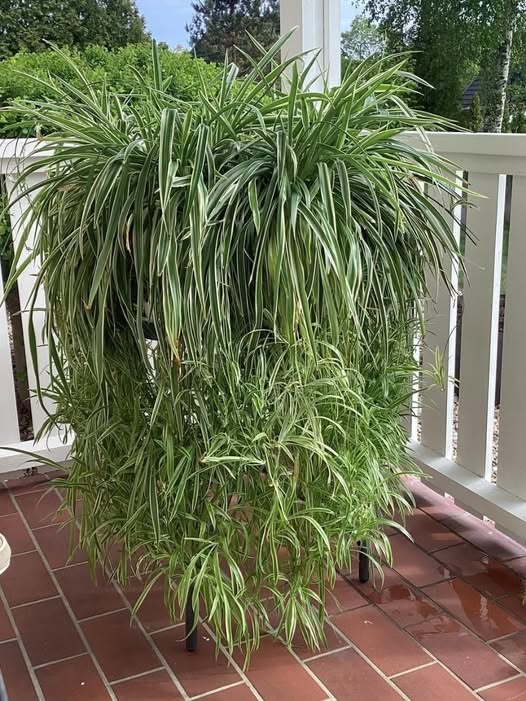Top 10 Secrets to Growing the Biggest, Healthiest Spider Plants
Spider plants (Chlorophytum comosum) are a favorite among indoor gardeners for good reason: they’re resilient, beautiful, and easy to care for, making them ideal for both beginners and seasoned plant enthusiasts. But if you want your spider plant to be lush, full, and thriving with vibrant green foliage and loads of baby plantlets, there are a few expert tips you’ll want to follow.
After years of growing and experimenting with spider plants, we’ve compiled this ultimate list of 10 proven secrets to help your spider plants grow to their full, stunning potential.
1. Provide Bright, Indirect Sunlight
Light is the #1 factor in how well your spider plant grows. While these plants are low-maintenance and adaptable, they thrive best in bright, indirect light.
- Place them near east or north-facing windows for ideal light exposure.
- Avoid harsh afternoon sun, which can scorch the leaves.
- If natural light is limited, fluorescent grow lights are a great alternative.
🌿 Proper lighting enhances their iconic green and white variegation and promotes baby plant production.
2. Use Coffee Grounds to Boost Growth
Yes, coffee grounds are a secret weapon for growing lush spider plants!
- Coffee grounds provide nitrogen, a key nutrient for leaf development.
- They also improve soil structure and repel pests like fungus gnats.
How to Use:
- Let used coffee grounds dry completely.
- Sprinkle a thin layer over the topsoil, or
- Mix with water to create a mild “coffee tea” fertilizer.
⚠️ Don’t overdo it — too much coffee can make the soil too acidic.
3. Choose the Right Pot and Soil
Spider plants have thick, fleshy roots that need space — but not too much. A slightly snug pot with excellent drainage is ideal.
- Always use pots with drainage holes to prevent root rot.
- Use a well-draining soil mix:
- 2 parts potting soil
- 1 part perlite or coarse sand
🪴 Repot every 1–2 years to refresh nutrients and prevent root crowding.
4. Water Properly and Consistently
Overwatering is the most common mistake with spider plants.
- Let the top inch of soil dry before watering again.
- During spring and summer, water about once a week.
- In fall and winter, cut back to once every 2–3 weeks.
Watering Tips:
- Always empty excess water from saucers.
- Use room-temperature water to avoid shocking the roots.
💧 Spider plants prefer slightly moist — not soggy — soil.
5. Feed Monthly During the Growing Season
Spider plants are moderate feeders that benefit from regular fertilization.
- Use a balanced liquid houseplant fertilizer (e.g. 10-10-10 or 20-20-20).
- Apply once a month in spring and summer.
- Skip feeding in winter when the plant is dormant.
🌱 Avoid over-fertilizing, which can cause brown tips or salt buildup.
6. Control Humidity and Temperature
Spider plants are happiest in environments that mimic their native South African climate.
- Ideal temperature: 65–75°F (18–24°C)
- Tolerates down to 50°F (10°C) but avoid cold drafts
- Prefers moderate humidity (40–60%)
Pro Tip:
- Mist leaves occasionally or place a humidifier nearby during dry winter months.
7. Prune for Shape and Health
Regular pruning keeps your spider plant neat, healthy, and full.
- Trim dead or yellowing leaves at the base.
- Snip off long runners if you don’t want baby plantlets (aka spiderettes).
- Prune brown leaf tips to keep the plant looking fresh.
✂️ Use clean, sharp scissors to prevent plant damage and disease.
8. Encourage Babies (Spiderettes)
Those adorable baby spider plants are a sign of a happy, mature plant.
To Encourage Spiderettes:
- Ensure bright, indirect light.
- Keep your plant slightly root-bound — a tighter pot encourages babies.
- Feed monthly during growing season.
Once you see spiderettes forming:
- Let them grow to a decent size.
- You can leave them attached, or
- Cut and propagate in water or soil to start new plants.
9. Watch for Common Issues
🟤 Brown Tips:
- Caused by fluoride in tap water, over-fertilization, or low humidity.
- Switch to filtered or distilled water and reduce fertilizer.
🟢 Pale or Drooping Leaves:
- Usually due to low light or overwatering.
🐜 Pests:
- Occasionally affected by spider mites, aphids, or mealybugs.
- Wipe leaves with neem oil or insecticidal soap as needed.
🧼 Also, wipe leaves with a damp cloth to remove dust and help the plant “breathe.”
10. Repot with Care
Repotting isn’t just about size—it’s also about refreshing the soil and promoting better nutrient uptake.
- Best time to repot: Spring
- Signs it’s time:
- Roots poking out of the drainage holes
- Water runs through the pot too quickly
- Soil dries out too fast
Choose a pot 1–2 inches wider than the current one and refresh the potting mix.
Bonus Tips for Next-Level Growth
- Rotate the pot monthly to ensure even growth on all sides.
- Clean your plant leaves to maximize photosynthesis.
- Let spiderettes root in a small pot while still attached to the mother plant for a stronger start.
Conclusion: Your Spider Plant Can Be a Showstopper
By following these top 10 secrets, your spider plant won’t just survive — it’ll thrive, bloom, and multiply. With proper light, soil, water, and a little love, your Chlorophytum comosum will reward you with lush green foliage, trailing babies, and a plant you’ll be proud to show off.
Whether you’re greening up a corner of your apartment or creating a full indoor jungle, the humble spider plant is your perfect companion — and now, you’ve got the tools to make it bigger, healthier, and more beautiful than ever.
